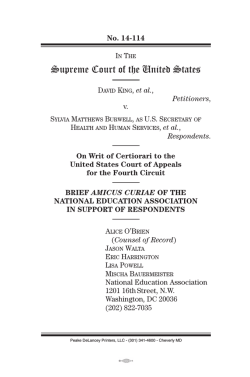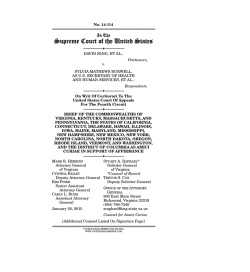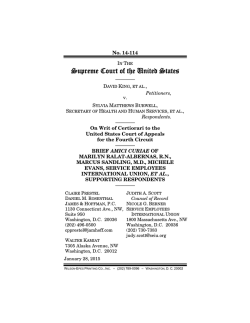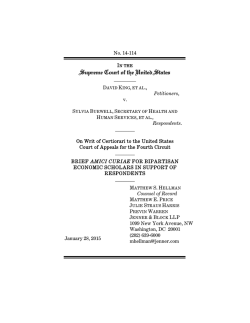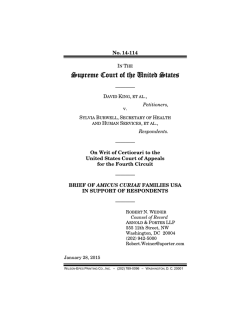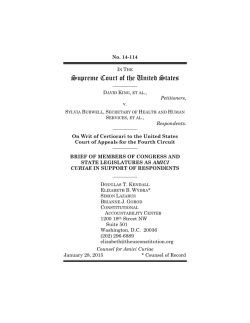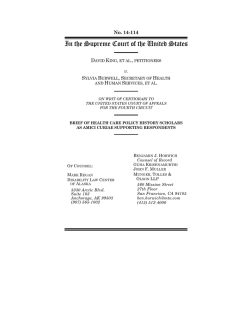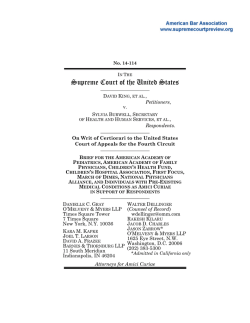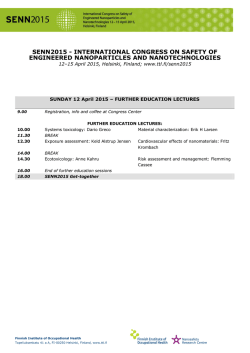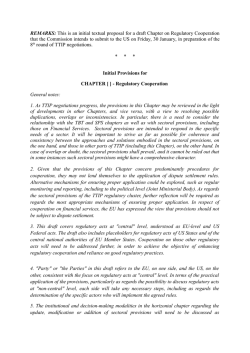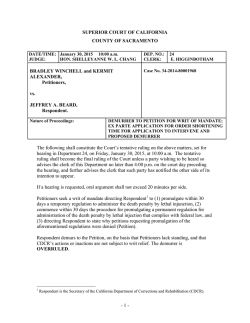
supporting brief - Washington Post
NO. 14-114 In the Supreme Court of the United States _______________ DAVID KING, ET AL., PETITIONERS v. SYLVIA MATHEWS BURWELL, SECRETARY OF HEALTH AND HUMAN SERVICES, ET AL., RESPONDENTS _______________ ON WRIT OF CERTIORARI TO THE UNITED STATES COURT OF APPEALS FOR THE FOURTH CIRCUIT _______________ BRIEF FOR PROFESSORS THOMAS W. MERRILL, GILLIAN E. METZGER, ABBE R. GLUCK, AND NICHOLAS BAGLEY AS AMICI CURIAE SUPPORTING RESPONDENTS _______________ GILLIAN E. METZGER CENTER FOR CONSTITUTIONAL GOVERNANCE COLUMBIA LAW SCHOOL 435 WEST 116TH ST. NEW YORK, N.Y. 10027 ABBE R. GLUCK 127 WALL STREET NEW HAVEN, CT 06511 JAMES A. FELDMAN Counsel of Record 5335 WISCONSIN AVE., N.W. SUITE 440 WASHINGTON, D.C. 20015 [email protected] (202) 730-1267 QUESTION PRESENTED Whether the Treasury Department permissibly interprets 26 U.S.C. §36B to make the Affordable Care Act’s federal premium tax credits available to eligible taxpayers through the Exchanges in every State. (i) TABLE OF CONTENTS Page Interest of the Amici ................................................. 1 Introduction and Summary of Argument ................ 2 Argument................................................................... 6 I. Statutes should be construed so as not to override the usual federal-state balance absent certainty that Congress so intended ........... 6 II. The language and structure of the ACA’s Exchange provisions, read as a whole and in light of federalism principles, support the government’s interpretation ...................... 11 A. The elimination of subsidies would yield dire consequences for the States if they did not set up Exchanges ................................ 12 B. When read as a whole, the Act does not provide the required certainty that Congress intended such drastic consequences ..... 15 III. The ACA’s Exchange provisions are a familiar type of cooperative federal-state regulatory program with a federal fallback, not a conditional spending program ....... 21 A. This Court has recognized two distinct types of cooperative federalism programs...... 22 B. The ACA is not analogous to conditional spending programs ......................................... 25 C. The ACA Exchanges are, instead, just like other cooperative federalism programs with a federal fallback ......................... 29 (iii) iv Conclusion ............................................................... 34 TABLE OF AUTHORITIES Page CASES Appalachian Power Co. v. EPA, 249 F.3d 1032 (D.C. Cir. 2001) .................................................. 31 Arlington Cent. Sch. Dist. Bd. of Educ. v. Murphy, 548 U.S. 291 (2006)............................... 8 Barnes v. Gorman, 536 U.S. 181 (2002) ................... 8 Batterton v. Francis, 432 U.S. 416 (1977) .........18, 24 Bond v. United States, 134 S. Ct. 2077 (2014) .. 6, 10, 11 Davis ex rel. LaShonda D. v. Monroe Cnty. Bd. of Educ., 526 U.S. 629 (1999) ......................... 8, 9 EPA v. EME Homer City Generation, 134 S. Ct. 1584 (2014) ................................................... 30 Fargo Packing v. Hardin, 312 F. Supp. 942 (D.N.D. 1970) ..................................................... 32 Fla. Dep’t of Revenue v. Piccadilly Cafeterias, Inc., 554 U.S. 33 (2008) ................................10, 19 Gonzales v. Oregon, 546 U.S. 243 (2006).....10, 20, 33 Gregory v. Ashcroft, 501 U.S. 452 (1991) ........ passim Jackson v. Birmingham Bd. of Educ., 544 U.S. 167 (2005) ............................................................. 9 Jones v. United States, 529 U.S. 848 (2000) .......... 10 Loughrin v. United States, 134 S. Ct. 2384 (2014) .................................................................. 10 N.Y. Tel. Co. v. N.Y. State Dep’t of Labor, 440 U.S. 519 (1979)................................................... 18 Nat’l Private Truck Council, Inc. v. Okla. Tax Comm’n, 515 U.S. 582 (1995) ............................ 10 (v) vi New York v. United States, 505 U.S. 144 (1992) ........................................................... passim NFIB v. Sebelius, 132 S. Ct. 2566 (2012) ........ passim Owasso Indep. Sch. Dist. No. I-011 v. Falvo, 534 U.S. 426 (2002) ............................................ 10 Pennhurst State School & Hospital v. Halderman, 451 U.S. 1 (1981) ..............7, 8, 20, 33 Philbrook v. Glodgett, 421 U.S. 707 (1975) ............ 33 Porter v. Nussle, 534 U.S. 516 (2002) ..................... 19 Saenz v. Roe, 526 U.S. 489 (1999) .......................... 28 South Dakota v. Dole, 483 U.S. 203 (1987) ............ 23 Suter v. Artist M., 503 U.S. 347 (1992) .................... 8 United States v. Bass, 404 U.S. 336 (1971) ............ 10 United States v. Enmons, 410 U.S. 396 (1973) ...... 10 Util. Air Regulatory Grp. v. EPA, 134 S. Ct. 2427 (2014) ......................................................... 31 W. Va. Hosp. v. Casey, 499 U.S. 83 (1991) ............. 22 Will v. Mich. Dep’t of State Police, 491 U.S. 58 (1989) .................................................................. 10 Wis. Dep’t of Health & Family Servs. v. Blumer, 534 U.S. 473 (2002) ............................. 18 STATUTES 20 U.S.C. §1411(d)(2) .............................................. 28 20 U.S.C. §6311(a)................................................... 27 20 U.S.C. §6311(b)................................................... 27 20 U.S.C. §6311(c) ................................................... 27 vii 21 U.S.C. §661(a)..................................................... 32 21 U.S.C. §661(c) ..................................................... 32 26 U.S.C. §223(a)..................................................... 29 26 U.S.C. §223(c)(1)(A) ............................................ 29 26 U.S.C. §3302(c)(3) ............................................... 28 26 U.S.C. §35 ........................................................... 26 26 U.S.C. §35(e)(1) .................................................. 26 26 U.S.C. §35(e)(2) .............................................26, 27 26 U.S.C. §36B ........................................................ 16 26 U.S.C. §36B(a) .................................................... 16 26 U.S.C. §36B(b) .......................................2, 3, 12, 17 26 U.S.C. §36B(b)(1) ................................................ 17 26 U.S.C. §36B(b)(2)(A) ........................................... 17 26 U.S.C. §36B(c)(1)(A) ........................................... 17 26 U.S.C. §36B(c)(2) ................................................ 17 26 U.S.C. §36B(c)(2)(A) ........................................... 17 29 U.S.C. §667(d)-(f) ................................................ 32 33 U.S.C. §1313(b)................................................... 31 42 U.S.C. §1396a(a)(10)(A)(i)(VIII) ........................ 15 42 U.S.C. §1396c ..................................................... 16 42 U.S.C. §1397aa(b)............................................... 25 42 U.S.C. §1397ee(d)(3)(A) ...................................... 26 42 U.S.C. §1397ff(c)(3) ............................................ 26 42 U.S.C. §18031 ..................................................... 18 42 U.S.C. §18031(f) ................................................. 19 viii 42 U.S.C. §18032(c)(1) ............................................. 14 42 U.S.C. §18041 ..........................................18, 19, 20 42 U.S.C. §18041(c)(1) ........................................18, 29 42 U.S.C. §18041(c). ................................................ 19 42 U.S.C. §18051 ..................................................... 19 42 U.S.C. §18082(e) ................................................. 19 42 U.S.C. §18091(2)(I) ........................................14, 21 42 U.S.C. §300gg ..................................................... 13 42 U.S.C. §300gg-22(a)............................................ 15 42 U.S.C. §602(a)(1)(A) ........................................... 28 42 U.S.C. §655(d)..................................................... 28 42 U.S.C. §7410(a)(1) .............................................. 30 42 U.S.C. §7410(c)(1) ............................................... 30 42 U.S.C. §7509(a)................................................... 31 42 U.S.C. Ch. 157 Subchap. III, Part C.................. 18 47 U.S.C. §252 ......................................................... 31 47 U.S.C. §252(e)(1) ................................................ 31 47 U.S.C. §252(e)(5) ................................................ 32 Age Discrimination in Employment Act, 29 U.S.C. §621........................................................... 9 Block Grants to States for Temporary Assistance for Needy Families, 42 U.S.C. §§601–619........................................................... 27 Child Support Enforcement Program, 42 U.S.C. §§651–669b ............................................. 28 Clean Air Act, 42 U.S.C. §7401 et seq .................... 30 ix Federal Unemployment Tax Act, 26 U.S.C. §§3301–3311....................................................... 28 Individuals with Disabilities Education Act, 20 U.S.C. §§1411–1419 ...................................... 28 Occupational Safety and Health Act, 29 U.S.C. §651 et seq .......................................................... 32 Patient Protection and Affordable Care Act (ACA), Pub. L. No. 111-148, 124 Stat. 119 passim State Children’s Health Insurance Program Reauthorization Act of 2009, 42 U.S.C. §§1397aa-1397mm ............................................. 25 Wholesome Meat Act, 21 U.S.C. §§601-695 ........... 32 OTHER AUTHORITIES Julie Stone-Axelrad & Bob Lyke, Cong. Research Serv., RL32620, Health Coverage Tax Credit Authorized by the Trade Act (2005) .................................................................. 26 Linda J. Blumberg et al., Robert Wood Johnson Found. & Urban Inst., The Implications of a Supreme Court Finding for the Plaintiff in King vs. Burwell: 8.2 Million More Uninsured and 35% Higher Premiums (2015) ................................................ 13 In the Supreme Court of the United States _______________ NO. 14-114 DAVID KING, ET AL., PETITIONERS v. SYLVIA MATHEWS BURWELL, ET AL., RESPONDENTS _______________ ON WRIT OF CERTIORARI TO THE UNITED STATES COURT OF APPEALS FOR THE FOURTH CIRCUIT _______________ BRIEF FOR PROFESSORS THOMAS W. MERRILL, GILLIAN E. METZGER, ABBE R. GLUCK, AND NICHOLAS BAGLEY AS AMICI CURIAE SUPPORTING RESPONDENTS _______________ INTEREST OF THE AMICI The Amici teach and write about federalism, constitutional law, and legislation.1 Thomas W. Merrill is Charles Evans Hughes Professor of Law at Columbia Law School. Gillian E. Metzger is Stanley H. Fuld The parties have consented to the filing of all briefs of amici curiae. No counsel for a party authored this brief in whole or in part, and neither counsel for a party nor a party made a monetary contribution intended to fund the preparation or submission of this brief. No person other than amici curiae or their counsel made a monetary contribution to its preparation or submission. 1 2 Professor of Law at Columbia Law School. Abbe R. Gluck is Professor of Law at Yale Law School. Nicholas Bagley is Assistant Professor of Law at the University of Michigan Law School. Amici submit this brief in the hope that its analysis of the federalism issues in this case will be of value to the Court.2 INTRODUCTION AND SUMMARY OF ARGUMENT The parties to this case have set forth two opposing interpretations of the Exchange provisions of the Patient Protection and Affordable Care Act (ACA), Pub. L. No. 111-148, 124 Stat. 119. Under petitioners’ interpretation, federal taxpayer subsidies are available only to those who purchase insurance on Exchanges that are set up by the States and are not available to those who do so on HHS-facilitated Exchanges. Under the government’s interpretation, federal subsidies are available to eligible taxpayers in every State, regardless of whether the State itself or HHS set up the Exchange in that State. Petitioners and the government, as well as the court below, have extensively discussed the texts and meanings of the relevant provisions of the ACA. Amici have a range of views on how the case would be resolved in the absence of the federalism considerations discussed in this brief. Some amici agree with the government that 26 U.S.C. §36B(b), read in the context of the Act’s text as a whole, plainly does not disqualify individuals who are enrolled in plans Institutional affiliations are provided for identification purposes only. This brief does not purport to present the institutional views, if any, of the named law schools. 2 3 through an Exchange operated by HHS from eligibility to receive premium tax credits. Other amici believe that the best understanding of Section 36B(b) would be a closer question, or that other provisions of the ACA establish ambiguity about the meaning of Section 36B(b). This brief does not rehearse the views of amici on the particular submissions of the parties. Amici wish to draw the Court’s attention, however, to a different aspect of this case. This Court has found that doctrines designed to preserve and protect the federalist structure established by the Constitution can and should have a significant impact on the interpretation of federal statutes. In particular, “it is incumbent upon the federal courts to be certain of Congress’ intent before finding that [a] federal law . . . overrides the usual constitutional balance of federal and state powers.” Gregory v. Ashcroft, 501 U.S. 452, 460 (1991) (internal quotation marks omitted). For the reasons given below, this Court’s federalism doctrines, applied in light of the ACA’s structure and context, support the proposition that the relevant text of the ACA is, at the least, ambiguous. Petitioners’ interpretation would result in a significant intrusion on the usual balance between the state and federal governments that is not clearly embodied in the statute.3 Under petitioners’ interpretation, a State’s choice not to establish its own insurance Exchange would result in elimination of subsidies for all of its residents, Amici do not address the question of what impact, if any, the Chevron doctrine has on this case. Instead, this brief addresses the application of federalism principles to judicial construction of the ACA itself. 3 4 which would in turn lead to a degradation of the insurance market in the State, thereby putting state residents in a much worse position than if Congress had not enacted the ACA at all. Yet the legislation not only failed to give States fair notice of that drastic consequence; it contains numerous other provisions strongly indicating that Congress intended no such thing. According to petitioners, Congress buried the momentous no-subsidy rule in a provision of the tax code directed to individuals, not States, and even there in a formula for calculating the monthly amount of a tax credit that an individual can claim. That is not, however, the way Congress addressed the consequences of State choices elsewhere in the Act. For example, the Medicaid provisions set out the consequences if a State declined to implement the ACA’s Medicaid expansion (held unconstitutional in NFIB v. Sebelius, 132 S. Ct. 2566 (2012)) in terms whose clarity no one doubted, not indirectly in a tax code provision. Petitioners’ understanding of how Congress prescribed the loss of subsidies also contrasts starkly with the Exchange provisions addressed directly to the States, which specifically define the consequences of a State’s failure to set up an Exchange. Under that provision, the consequence of a State’s failure to set up an Exchange is simply that HHS would set up an equivalent Exchange in that State instead—with no mention of the loss of subsidies for state residents. Indeed, Congress’s very decision to provide for alternative HHS-facilitated Exchanges would make no sense under petitioners’ view, since those Exchanges would quickly cease to function 5 and could not possibly provide the key benefit—increased access to affordable health insurance—that is the central objective of the Act. Petitioners mistakenly seek to characterize the ACA’s Exchange provisions as analogous to a conditional spending program. Under such a program, Congress offers grants to States if they agree to comply with stated federal conditions. If a State does not agree to comply, the consequence is directly stated and obvious: the State does not get the federal funds, and the federal program will not be implemented in that State. Here, by contrast, the crucial consequence, as noted, is buried in a provision prescribing calculation of individuals’ tax credits. Moreover, conditional spending programs typically leave a State that chooses not to participate in the program in roughly the same situation as if the legislation had not been enacted. Here, by contrast, the ACA would (on petitioners’ view) leave a nonparticipating State and its residents in much worse condition, with the threatened destabilization of the State’s entire individual insurance market. Instead, the ACA is a typical example of the other standard model of cooperative federalism—a federalstate regulatory program. As this Court explained in New York v. United States, 505 U.S. 144, 167-168 (1992), this model has an entirely different structure and goal from a conditional spending model. Such programs, like the ACA, offer the States the opportunity to administer or enforce a federal program, but provide as well for a federal fallback if a State chooses not to do so. Crucially, in such cases, the State’s 6 choice determines only whether the program is implemented by a State or by a federal agency; it will be fully implemented in either event. Congress structured the ACA’s Exchange provisions in precisely this way. These structural and contextual characteristics, together with the Court’s federalism doctrines, strongly suggest that the government’s interpretation should be adopted. ARGUMENT I. STATUTES SHOULD BE CONSTRUED SO AS NOT TO OVERRIDE THE USUAL FEDERALSTATE BALANCE ABSENT CERTAINTY THAT CONGRESS SO INTENDED The Court explained just last Term that “Congress legislates against the backdrop of certain unexpressed presumptions,” among which are “those grounded in the relationship between the Federal Government and the States.” Bond v. United States, 134 S. Ct. 2077, 2088 (2014) (internal quotation marks omitted). Therefore, as the Court has repeatedly held, “it is incumbent upon the federal courts to be certain of Congress’ intent before finding that federal law overrides . . . the usual constitutional balance of federal and state powers.” Gregory, 501 U.S. at 460 (internal quotation marks omitted); accord New York, 505 U.S. at 170. That rule most accurately reflects the meanings of the laws Congress enacts, while at the same time safeguarding one of the foundations of our constitutional order. It preserves the rule of law in a complicated statutory landscape by ensuring that Congress, courts, States, and their residents are afforded notice of how federal legislation will affect the federal-state balance. Although disregarded entirely 7 by petitioners, that rule, reflected in many of this Court’s cases, is of direct relevance to the interpretation of a federal-state program such as that embodied in the ACA. 1. Pennhurst State School & Hospital v. Halderman, 451 U.S. 1 (1981), involved “a federal-state grant program whereby the Federal Government provides financial assistance to participating States to aid them in creating programs to care for and treat the developmentally disabled.” Id. at 11. The statute provided that States “have an obligation to assure that public funds are not provided to any institutio[n] . . . that . . . does not provide treatment, services, and habilitation which is appropriate to the needs of [a] person [with developmental disabilities]; or . . . does not meet [certain] minimum standards.” Id. at 13. Plaintiff argued that this provision required the State, if it accepted the federal money, to provide for deinstitutionalization of those under its care. The Court rejected that reading, reasoning that it would “def[y] common sense . . . to suppose that Congress implicitly imposed this massive obligation on participating States.” 451 U.S. at 24. The Court explained that the States cannot play their proper role in the federal system unless they know in advance the consequences of their decisions to participate in a federal program. “There can . . . be no knowing acceptance” of a condition on federal funds “if a State is unaware of the conditions or is unable to ascertain what is expected of it.” Id. at 17. Because imposition and enforcement of vague or unclear federal conditions on the States would upset the usual federalstate balance, the Court held that any “condition on 8 the grant of federal moneys” must be imposed “unambiguously.” Ibid. “Respecting [the Pennhurst] limitation is critical to ensuring that Spending Clause legislation does not undermine the status of the States as independent sovereigns in our federal system.” NFIB, 132 S. Ct. at 2602 (Roberts, C.J., joined by Breyer and Kagan, JJ.).4 This case does not involve a conditional spending program as in Pennhurst (although petitioners characterize the Exchanges as analogous, see pp. 25-29, infra).5 Nevertheless, Pennhurst and related decisions more broadly reflect a strong interpretive presumption that when Congress intends to impose conditions on States’ choices that would result in significant consequences, it does so unambiguously. In order to function as sovereigns and protect the interests of their people, including in the legislative process itself, the States are entitled to know the legal consequences of their decisions to participate in a federalstate program. Only then “can they guard against excessive federal intrusion into state affairs and be vig- 4 The Court has applied the Pennhurst rule in many Spending Clause cases. See, e.g., Arlington Cent. Sch. Dist. Bd. of Educ. v. Murphy, 548 U.S. 291, 296 (2006); Barnes v. Gorman, 536 U.S. 181, 185-88 (2002); Davis ex rel. LaShonda D. v. Monroe Cnty. Bd. of Educ., 526 U.S. 629, 639-42 (1999); Suter v. Artist M., 503 U.S. 347, 358 (1992). Congress’s power to mandate the creation of the Exchanges by conditional regulation is not challenged in this case, and rests on a combination of the Commerce Clause and the Spending Clause, as supplemented by the Necessary and Proper Clause. Certainly, Congress’s power to provide for federal tax credits on Exchanges operated by HHS is beyond doubt. 5 9 ilant in policing the boundaries of federal power.” Davis ex rel. LaShonda D. v. Monroe Cnty. Bd. of Educ., 526 U.S. 629, 655 (1999) (Kennedy, J., dissenting).6 Similarly, only if States receive clear notice of the consequences under federal law of declining to participate in a federal program of the sort at issue here can they serve their proper role in the legislative process and in our federal system. 2. The Court has consistently applied analogous federalism principles to statutes outside the conditional spending context. In Gregory, the Court considered whether a state constitutional provision setting a mandatory retirement age for state judges violated the Age Discrimination in Employment Act (ADEA), 29 U.S.C. §§621-634. The Court noted that “[c]ongressional interference with th[e] decision of the people of Missouri, defining their constitutional officers, would upset the usual constitutional balance of federal and state powers.” 501 U.S. at 460. The Court therefore emphasized that, before concluding that the ADEA had that effect, “it must be plain to anyone reading the Act that it covers judges.” Id. at 467. Applying that principle, the Court concluded that state Amici take no position on when the requisite notice to states might be found by reading statutory terms in light of the Court’s previous rulings concerning similar provisions, cf. Jackson v. Birmingham Bd. of Educ., 544 U.S. 167, 174-177 (2005); Davis, 526 U.S. at 641-42, 649-650, or by pointing to regulatory materials promulgated by an agency to which Congress has delegated authority, cf. id. at 643-644, 647. The instant case does not raise any such questions. 6 10 judges fell within an ADEA exception for an “appointee on the policymaking level.” Id. at 456 (internal quotation marks omitted).7 This Court has applied these principles time and again, both in the regulatory context, as in Gregory and Gonzales v. Oregon, 546 U.S. 243, 248 (2006), and in construing federal criminal statutes. Just last Term, in Bond, 134 S. Ct. at 2090, the Court rejected a broad construction of a chemical weapons statute because it “does not constitute a clear statement that Congress meant the statute to reach local criminal conduct.”8 3. The above cases arise in different contexts and address a variety of ways in which statutes can alter the usual balance between the federal and state governments. The underlying principle in all of these cases, however, is that a court must be certain of Congress’s intent before finding that Congress meant to 7 The Court has applied similar principles in many other cases in which the application of federal statutes to regulate the States and their officers would otherwise upset the usual federal-state balance. See, e.g., Fla. Dep’t of Revenue v. Piccadilly Cafeterias, Inc., 554 U.S. 33, 48-52 (2008) (federal bankruptcy provision affecting state taxing authority); Owasso Indep. Sch. Dist. No. I-011 v. Falvo, 534 U.S. 426, 432-436 (2002) (federal education provision affecting privacy of student records); Nat’l Private Truck Council, Inc. v. Okla. Tax Comm’n, 515 U.S. 582, 586-592 (1995) (federal law interfering with state tax functions); Will v. Mich. Dep’t of State Police, 491 U.S. 58, 65 (1989) (Section 1983’s applicability to States). See also, e.g., Loughrin v. United States, 134 S. Ct. 2384, 2392 (2014); Jones v. United States, 529 U.S. 848, 850 (2000); United States v. Enmons, 410 U.S. 396, 411 (1973); United States v. Bass, 404 U.S. 336, 350 (1971). 8 11 upset that balance. A court may not construe a statute to do so unless, as the Court said in Gregory, “it [is] plain to anyone reading the Act” that Congress intended that effect. 501 U.S. at 467; accord Bond, 134 S. Ct. at 2089. In applying that canon, the Court has been especially careful to consult an entire statute, including its context and structure, before accepting an interpretation of a particular provision that would dramatically intrude upon the States’ position. II. THE LANGUAGE AND STRUCTURE OF THE ACA’S EXCHANGE PROVISIONS, READ AS A WHOLE AND IN LIGHT OF FEDERALISM PRINCIPLES, SUPPORT THE GOVERNMENT’S INTERPRETATION Petitioners argue (at Br. 2-3) that Congress intended to encourage the States to set up Exchanges, through a combination of “carrots” and “sticks.” Under their interpretation, the primary “stick” is the threat that, if a State does not do so, its residents lose access to federal subsidies. According to petitioners, Congress was confident that the States would set up Exchanges. But, as petitioners describe the Act, Congress was content that the ACA’s signature reform— increased access to affordable health insurance— would not be realized in States that chose not to set up Exchanges. On petitioners’ reading, not only would the aims of the federal program not be realized, but because of the effects of the lack of subsidies, the HHS-facilitated Exchanges in those States and the States’ entire individual health insurance markets would suffer destabilization and potential collapse. Residents of a nonparticipating State would be much worse off than if Congress had not acted at all. 12 Such a drastic consequence requires much more textual clarity than petitioners’ reading offers. Petitioners focus narrowly on one provision of the Act, 26 U.S.C. §36B(b), a provision that addresses individuals. But consideration of the Act as a whole and its provisions that directly address the States demonstrate that Congress designed a program built upon well-understood principles of cooperative federalism. The ACA’s Medicaid provisions illustrate that Congress knows how to design a conditional spending program of the type petitioners describe and knows how to speak clearly to the States when severe consequences are at issue. The provisions relating to Exchanges are starkly different, with no clear statement of the no-subsidy consequence petitioners’ reading would impose. Instead, those provisions inform the States that, if they choose not to set up an Exchange, a federal fallback will go into effect to ensure nationwide implementation. Indeed, the very existence of a federal fallback designed to be dysfunctional—a necessary consequence of petitioners’ interpretation— would be incoherent. Especially in a statutory scheme as complex as this one, it is critical that statutory language be read not in hyper-isolation but in its actual structural and linguistic context. A. The Elimination of Subsidies Would Yield Dire Consequences for the States If They Did Not Set Up Exchanges This case is about the key consequence that petitioners argue would follow from States’ decisions not to set up Exchanges—the loss of the federal subsidies for their residents. It is impossible to overstate the impact of the elimination of such subsidies. The 13 Court should not construe a statute to have such impact unless it can be certain that the statute requires it and the States had adequate notice. 1. The immediate impact of the absence of federal subsidies would be the loss of a huge number of federal dollars in subsidies for the State’s residents.9 But even further, without subsidies, the insurance market in the State would become unstable, with increasing prices and threat of ultimate collapse. The government’s brief (at 4-7, 36-38) and supporting amicus briefs of America’s Health Insurance Plans (AHIP) and Economic Scholars explain the process of this “death spiral” in detail. The result: insurance offered through an HHS-facilitated Exchange would become unaffordable for many and much more expensive (and less available) for those who could still afford it. 2. As AHIP and the Economic Scholars explain, however, the consequences would extend much deeper. The Act’s guaranteed issue and community rating provisions have nationwide applicability and require insurers to issue policies to all comers at rates that discriminate on the basis of only a few permitted factors. 42 U.S.C. §§300gg, 300gg-1 to -4. Those provisions thus apply to all insurers, not only those who offer insurance through the Exchanges. Accordingly, See Linda J. Blumberg et al., Robert Wood Johnson Found. & Urban Inst., The Implications of a Supreme Court Finding for the Plaintiff in King vs. Burwell: 8.2 Million More Uninsured and 35% Higher Premiums 5 (2015) (“Foregone premium tax credits amount to $25.2 billion, while foregone cost sharing reductions amount to $3.7 billion. We estimate that, over a 10 year window, the loss of federal financial assistance would be about $340 billion.”). 9 14 under petitioners’ interpretation of the Act, the offExchange individual insurance market would suffer the same ultimately fatal instability as the Exchanges would, for the same reasons. Just as on the Exchanges, insurers on the off-Exchange market would be required to insure all comers at nondiscriminatory prices. Just as on the Exchanges, that offer would be attractive primarily to those who know they are likely to suffer high medical costs.10 3. Congress understood the interconnection between the various reforms in the ACA and the devastating effects of implementing some of them without the others. See 42 U.S.C. §18091(2)(I) (statutory finding that making coverage available to a broader pool “is essential to creating effective health insurance markets” (emphasis added)). Under petitioners’ view, therefore, Congress intended to put the States to a most drastic choice: either set up an Exchange, or face the destabilization and possible destruction of the individual insurance market in the State. For a nonparticipating State, the consequence of its choice would be not merely to deprive its residents of the benefits offered by the federal program. By declining to participate, the State would make its residents who had previously relied on the private market much worse off than if Congress had never enacted the ACA. Several mechanisms, including the requirement that insurers treat covered individuals as a single risk pool, regardless of whether they purchase insurance on or off the Exchanges, 42 U.S.C. §18032(c)(1), would accelerate the infection from the Exchanges to the off-Exchange market. 10 15 Moreover, the instruments of that harm to State residents would, on petitioners’ theory, be the very insurance commissioners who, under the ACA, have been vested with primary responsibility for enforcing its insurance provisions. See 42 U.S.C. §300gg-22(a). Petitioners would thus read this provision not to reflect congressional solicitude for state authority, but rather to instruct state officers to enforce rules that would destroy the very markets that they oversee. B. When Read as a Whole, the Act Does Not Provide the Required Certainty that Congress Intended Such Drastic Consequences This Court’s federalism cases establish that the Court should not assume Congress has enacted a program in which States are put to a choice with those kinds of drastic consequences unless there is “certain[ty]” that Congress intended it. Gregory, 501 U.S. at 460. When the Act is read as a whole, such clarity is absent here. 1. The Medicaid provisions are a case in point, and provide a stark contrast to the Exchange provisions. Medicaid is a prime example of a conditional spending program. In the ACA’s Medicaid expansion provisions that the Court held unconstitutional in NFIB, Congress spoke clearly to the additional responsibilities it wanted participating States to undertake, requiring “state programs to provide Medicaid coverage to adults with incomes up to 133 percent of the federal poverty level.” NFIB, 132 S. Ct. at 2582; see 42 U.S.C. §1396a(a)(10)(A)(i)(VIII). Indeed, Medicaid has always made its consequences clear, providing that “[i]f the Secretary . . . finds . . . that in the administration 16 of the plan there is a failure to comply substantially with any . . . provision[,] the Secretary shall notify such State agency that further payments will not be made to the State.” 42 U.S.C. §1396c. The Act thus made clear that “[i]f a State does not comply with the Act’s new coverage requirements, it may lose not only the federal funding for those requirements, but all of its federal Medicaid funds.” NFIB, 132 S. Ct. at 2572. There was argument in NFIB about whether the Medicaid condition was unconstitutionally coercive, and about whether the expansion fit into Medicaid’s reservation of the right to alter or amend the program. Id. at 2605-06. But there was no dispute about the textual clarity of the consequence Congress imposed, requiring states to expand their Medicaid programs or face loss of all Medicaid funds. Id at 2601. 2. That clarity contrasts dramatically with the provisions at issue in this case. Under petitioners’ interpretation, Congress did not expressly spell out the central consequence of not setting up an Exchange— the denial of subsidies to state residents—in a provision (or even in a Title of the U.S. Code) addressed to the States. Indeed, Congress did not spell out that consequence at all. Instead, that momentous consequence is said to be an implicit result of a provision in the tax code addressed to individuals, entitled “Refundable credit for coverage under a qualified health plan.” 26 U.S.C. §36B. That provision purports to tell individual taxpayers how much “shall be allowed as a credit against” their income tax. 26 U.S.C. §36B(a). Moreover, even within that provision, Congress did not include this consequence in the operative provision itself (26 U.S.C. §36B(a)), nor in the definition 17 of “applicable taxpayer[s]” who are eligible for the tax credit, 26 U.S.C. §36B(c)(1)(A). The definition of “applicable taxpayer[s]” turns on income and does not mention whether the Exchange in question is operated by the State in which the taxpayer resides or by HHS. Instead, according to petitioners, Pet. Br. 3, 18, Congress imposed this drastic consequence in a provision that defines the “coverage months” for an applicable taxpayer’s credits each year, 26 U.S.C. §36B(b)(1); see also 26 U.S.C. §36B(b)(2)(A). A “coverage month” is defined as any month if . . . as of the first day of such month the taxpayer, the taxpayer’s spouse, or any dependent of the taxpayer is covered by a qualified health plan described in subsection (b)(2)(A) that was enrolled in through an Exchange established by the State under section [18031] of the [ACA] and . . . the premium for coverage under such plan for such month is paid by the taxpayer . . . 26 U.S.C. §36B(c)(2)(A) (emphasis added).11 Because under petitioners’ interpretation the number of “coverage months” in nonparticipating States will always be zero, residents of those States are ineligible for tax subsidies.12 In that obscure way, Congress is said to 11 The titles of these provisions certainly give no indication that they were addressed to, or imposed consequences on, the States. Section 36B(b) is entitled “Premium assistance credit amount.” Section 36B(c)(2) is entitled “Coverage months.” Petitioners assert (Br. 18) that another equally buried provision in Section 36B(b) “[r]einforces” and “presupposes” their point. That provision is even less direct, and even petitioners do not place primary reliance on it. 12 18 have informed the States of the consequences of their decisions whether to establish Exchanges. 3. Other provisions of the Act do directly address the States—not individual taxpayers—with respect to their role in setting up Exchanges. For example, 42 U.S.C. §18031 provides for States to set up Exchanges. If they fail to do so, Section 18041 explains what will happen in direct terms: If a State “will not have any required Exchange operational” by the effective date, or if the State “has not taken actions the Secretary determines necessary to implement . . . the other requirements” relating to Exchanges, then “the Secretary shall . . . establish and operate such Exchange.” 42 U.S.C. §18041(c)(1). Section 18041 itself is clear about the federal-state relationship that Congress intended. It is one that allows States “flexibility” and is a classic example of the cooperative model of federalism that this Court has held should be favored in statutory interpretation.13 The very title of Section 18041—the section about the consequences of failing to establish an Exchange— underscores the point: “State flexibility in operation and enforcement of Exchanges and related requirements.” 42 U.S.C. §18041 (emphasis added). Moreover, Section 18041 is located in a Part of the Act entitled “State Flexibility Relating To Exchanges.” 42 U.S.C. Ch. 157, Subchap. III, Part C (emphasis See, e.g., Wis. Dep’t of Health & Family Servs. v. Blumer, 534 U.S. 473, 495 (2002); N.Y. Tel. Co. v. N.Y. State Dep’t of Labor, 440 U.S. 519, 539 n.31 (1979) (plurality opinion); Batterton v. Francis, 432 U.S. 416, 431-432 (1977). 13 19 added).14 The intent of the ACA here, stated in plain text, is to give States flexibility, not to put them in a straitjacket that threatens drastic consequences if they choose not to participate.15 If Congress had intended petitioners’ interpretation, a subsection of Section 18041 entitled “Failure to establish Exchange or implement requirements” would surely have been the logical place to put it. 42 U.S.C. §18041(c). Instead, Congress kept all of Section 18041 scrupulously free of any mention of this crucial consequence, while emphasizing in that provision the States’ flexibility to decide, one way or the other, whether to set up Exchanges. Moreover, the contrast with the express choice given to States in the Medicaid provisions could not be clearer. This Court has held that when Congress speaks directly in one provision to the effect of legislation upon the States, the Court will not read another provision relating to the same program to have See Fla. Dep’t of Revenue v. Piccadilly Cafeterias, Inc., 554 U.S. 33, 47 (2008) (“[S]tatutory titles and section headings are ‘tools available for the resolution of a doubt about the meaning of a statute.’” (quoting Porter v. Nussle, 534 U.S. 516, 528 (2002)). 14 15 Indeed, Congress further emphasized the point by using the term “flexibility” or “state flexibility” in four other parts of Title I of the Act, which is directed to Exchanges. See 42 U.S.C. §18031(f) (entitled “Flexibility” and permitting States to set up regional Exchanges); §18051 (entitled “State flexibility to establish basic health programs for low-income individuals not eligible for Medicaid”); Part D (entitled “State Flexibility to Establish Alternative Programs”); §18082(e) (provision entitled “State flexibility” and permitting States to defray costs of individuals for purchasing insurance on Exchanges). 20 the same effect without the same level of clarity. See Pennhurst, 451 U.S. at 13-14, 23; see also Gonzales, 546 U.S. at 273-74. Indeed, if petitioners’ interpretation were correct, the lack of clarity had significant real-world effects, misleading the States (and virtually everyone else) into believing that a State’s choice whether to set up an Exchange would not affect the ability of state residents to obtain federal subsidies. The Brief of Amici Curiae Virginia, et al., Supporting Respondents makes clear that the States were entirely unaware of what petitioners claim to be the plain meaning of the ACA while the Act was being considered and when they decided whether to set up Exchanges. The fact that, under petitioners’ interpretation, States were led to make choices about participation in this federal program with virtually no notice of the consequences of those choices, and no opportunity to react to or influence the imposition of that choice during the legislative process, is a strong reason to reject that interpretation. 4. Finally, the very existence of the HHS-facilitated Exchanges as a federal fallback is itself strong evidence that Congress intended that the program could and would effectively operate with the “flexibility” for the States it provided for in Section 18041. As four Justices in NFIB recognized, “because Congress thought that some States might decline federal funding for the operation of a ‘health benefit exchange,’ Congress provided a backup scheme; if a State declines to participate in the operation of an exchange, the Federal Government will step in and operate an 21 exchange in that State.” 132 S. Ct. at 2665 (Scalia, Kennedy, Thomas, and Alito, JJ., dissenting). According to petitioners, while Congress instructed HHS to set up an Exchange if a State did not do so, the HHS-facilitated Exchange would, even at its inception, be unable to offer access to the absolutely crucial benefit—federal subsidies. The HHSfacilitated Exchanges would collapse as insurers dropped out (and the balance of the individual market would be destabilized as well). There is no plausible reason why Congress would have wanted HHS to set up dysfunctional Exchanges, without the crucial subsidy “essential” to permit them to function. 42 U.S.C. §18091(2)(I); see NFIB, 132 S. Ct. at 2674 (Scalia, Kennedy, Thomas, and Alito, JJ., dissenting) (“That system of incentives collapses if the federal subsidies are invalidated. . . . With fewer buyers and even fewer sellers, the exchanges would not operate as Congress intended and may not operate at all.”). Surely, at a minimum, there can be no “certainty” that Congress intended to establish such a dysfunctional federal fallback program. III. THE ACA’S EXCHANGE PROVISIONS ARE A FAMILIAR TYPE OF COOPERATIVE FEDERAL-STATE REGULATORY PROGRAM WITH A FEDERAL FALLBACK, NOT A CONDITIONAL SPENDING PROGRAM Petitioners incorrectly characterize the ACA’s Exchange provisions as analogous to other statutes that leave the fate of the federal program entirely in the hands of the States. The Court has recognized that the “record of statutory usage” across the whole code sheds light on how ambiguous terms should be read. 22 W. Va. Hosp. v. Casey, 499 U.S. 83, 88 (1991) (construing “attorney’s fees” in a statute by examining the term’s use in more than 40 other statutes). Here, that record reveals that Congress in the ACA employed a familiar cooperative-federalism model that would achieve nationwide implementation. In its federalism case law, this Court has distinguished two models of cooperative federal-state programs. One is a federal regulatory program in which Congress desires full nationwide implementation, allowing for optional State participation but with a federal fallback regime if a State chooses not to participate. The other is a conditional spending program, in which Congress offers funds to States to provide services under the conditions specified. If a State does not accept the offer or satisfy the conditions, the program is not implemented in that State. The ACA’s Exchange provisions follow the familiar model of a federal regulatory program with a federal fallback to achieve nationwide implementation, not, as petitioners argue, a conditional spending program. The ACA’s adherence to the federal regulatory model strongly supports the proposition that Congress intended, as in other programs that follow this model, that the federal fallback have full effect and therefore that Congress intended that subsidies be available on HHS-facilitated Exchanges. A. This Court Has Recognized Two Distinct Types of Cooperative Federalism Programs In New York v. United States, 505 U.S. 144, 166 (1992), this Court recognized that, although there are 23 “a variety of methods, short of outright coercion, by which Congress may urge a State to adopt a legislative program consistent with federal interests,” two such methods are of particular interest. 1. First, “Congress may attach conditions on the receipt of federal funds.” South Dakota v. Dole, 483 U.S. 203, 206 (1987). If such conditions meet certain constitutional requirements, including that they “bear some relationship to the purpose of the federal spending,” New York, 505 U.S. at 167, and are not unduly coercive, NFIB, 132 S. Ct. at 2602-03, they “may influence a State’s legislative choices.” New York, 505 U.S. at 167. Legislation establishing such conditional spending programs ordinarily informs the States in direct and clear language what is obvious: If they fail to satisfy the federal conditions, they will not get the funds. So long as the federal conditions are clear and meet other constitutional requirements described in Dole, New York, and NFIB, conditional spending programs are constitutionally permissible, because “the residents of the State retain the ultimate decision as to whether or not the State will comply” with the deal Congress has offered. New York, 505 U.S. at 168. “If a State’s citizens view federal policy as sufficiently contrary to local interests, they may elect to decline a federal grant.” Ibid. Thus “state governments remain responsive to the local electorate’s preferences; state officials remain accountable to the people.” Ibid. That can occur, however, only if the State and its residents are aware of the consequences of the State’s choices while the legislation is being considered and 24 when the State decides whether to accept the federal funds. 2. The second model is very different. If Congress creates a regulatory program, Congress may “offer States the choice of regulating . . . activity according to federal standards or having state law pre-empted by federal regulation.” New York, 505 U.S. at 167. In such programs, a federal fallback comes into play if a State chooses not to participate. But whether or not the State participates, the federal regulatory program is implemented and its objectives are realized. “If state residents would prefer their government to devote its attention and resources to problems other than those deemed important by Congress, they may choose to have the Federal Government rather than the State bear the expense of a federally mandated regulatory program” through the federal fallback. Id. at 168. 3. A critical difference between these two types of federal-state programs is that conditional spending programs usually leave the field untouched if the State declines the federal grant. Whether because of the extra resources needed for direct federal provision of services, a lack of constitutional authority, or other reasons, Congress is generally satisfied to offer the States funds in conditional spending programs, but is then willing to accept that “[t]he congressional purpose is not served at all in those States” that decline to participate. Batterton v. Francis, 432 U.S. 416, 431 (1977). Federal-state regulatory programs typically have a very different structure and goal. Such programs seek to enlist the State’s cooperation, but if a State 25 declines to cooperate, the federal government then implements the legislation itself. The goal is a nationwide effect, and it is achieved either way. B. The ACA Is Not Analogous to Conditional Spending Programs Petitioners’ amici Oklahoma, et al., and Missouri Liberty Project cite a number of federal spending programs. In each one, unlike the ACA under petitioners’ interpretation, the consequences of a State’s failure to participate are obvious and spelled out in the terms of the statute aimed directly at the State, not buried in a provision about individual taxes. None of them includes a federal fallback like the HHS-facilitated Exchanges. In addition, in each one, if the State chooses not to participate, the result is that the State and its residents are left approximately where they would have been if Congress had not offered the State the choice. Not one of the statutes that petitioners and amici cite would impose anything like the dire consequences that petitioners’ reading would impose on a State’s choice not to set up an Exchange. 1. Petitioners’ amici invoke the State Children’s Health Insurance Program Reauthorization Act of 2009, 42 U.S.C. §§1397aa-1397mm (“SCHIP”). See Okla. Br. 8-9, Adler-Cannon Br. 23. As is the norm in conditional spending programs, the statute spells out the consequence of a State’s decision not to abide by the terms of a spending condition in clear, “if/then” or “unless” terms: “A State is not eligible for payment . . . unless the State has submitted to the Secretary . . . a plan” that sets forth how funds will be used and that has been approved. 42 U.S.C. §1397aa(b); see 26 also 42 U.S.C. §1397ff(c)(3) (“In the case of a disapproval of a plan or plan amendment, the Secretary shall provide a State with a reasonable opportunity for correction before taking financial sanctions against the State on the basis of such disapproval.”); 42 U.S.C. §1397ee(d)(3)(A) (standards for approval). In contrast, 26 U.SC. §36B(b) under petitioners’ interpretation does not include any such clear terms putting the States on notice of the crucial consequence— loss of federal tax subsidies for its residents—of not setting up an Exchange.16 16 Petitioners mistakenly argue (Br. 30) that a health coverage tax credit (HCTC) codified at 26 U.S.C. §35 establishes that “it is not unusual for Congress to put conditions on receipt of a tax credit into the formula for its amount.” HCTC was not part of any overarching health care reform; because the only health benefit offered was a tax credit, it is unsurprising that it was placed in the tax provisions. HCTC was a targeted attempt, as part of a trade act, to help trade-displaced workers obtain health insurance. 26 U.S.C. §35(e)(1). States were not central to the HCTC program; three of the eleven categories of “qualified” insurance programs in the act (including COBRA) had nothing to do with the States and accounted for over 56 percent of enrollments. Julie Stone-Axelrad & Bob Lyke, Cong. Research Serv., RL32620, Health Coverage Tax Credit Authorized by the Trade Act 24 (2005). Unlike the ACA, HCTC was certainly not a part of an interdependent set of provisions to regulate an industry on a nationwide basis. There was no federal fallback and no other indication that Congress wanted to ensure that HCTC would operate in every State or would guarantee that every displaced worker—much less everyone who might need health care— would have access. In any event, contrary to petitioners’ contention, the effect of a State's decision not to get “qualified” status for one of its insurance programs was not buried in a formula for calculating the amount of the credit. It was in a definition of the key term—“qualified insurance”—for which the credit was available. 26 U.S.C. §35(a), (e)(2). And the requirements for a state 27 In addition, if a State never participates in the SCHIP, the children of the State will be no worse off than if the program had never existed. Under petitioners’ interpretation, by contrast, the ACA was designed so that a State’s decision not to set up an Exchange would risk the pre-ACA ability of its residents to obtain insurance on the individual market. 2. Amici also cite the No Child Left Behind Act of 2001, codified in various sections of 20 U.S.C. See Okla. Br. 7-8; Mo. Liberty Br. 8. The Act is essentially a grant program, see 20 U.S.C. §6311(a), and the major consequence for a State of not participating is that it will not receive funds for its educational programs. The Act spells out in careful detail the conditions on the grant, the violation of which will cause the cessation of funding. See, e.g., 20 U.S.C. §6311(b), (c). As with all the other programs cited by amici, if a State does not participate, the State may still provide its children with whatever education it chooses to provide, as if there had been no federal program. Under petitioners’ interpretation of the ACA, by contrast, Congress surreptitiously designed the program so that the pre-ACA individual health insurance market would be threatened with collapse. 3. Amici cite the Block Grants to States for Temporary Assistance for Needy Families program, 42 U.S.C. §§601–619. See Mo. Liberty Br. 7. That program is also a block grant program, in which States can obtain federal grants to provide their residents with certain subsistence welfare programs, so long as plan to be “qualified” were clear and directed to the State. See 26 U.S.C. §35(e)(2) (“Requirements for State-based coverage”). 28 they comply with federal requirements. See, e.g., 42 U.S.C. §602(a)(1)(A); see also Saenz v. Roe, 526 U.S. 489, 492-493 (1999). Similar to the above programs, if a State participates, it receives the money and agrees to provide benefits to its residents in accordance with the federal conditions. If it does not participate, it does not receive the money, and its residents do not obtain the benefits. As with the above programs, however, even if the State chooses not to receive the benefits, the State’s residents will not be subject to the sort of dire consequences that petitioners’ reading of the ACA would impose. 4. The other conditional spending programs cited by amici all have similar features.17 The programs all provide grants to the States. If a State chooses not to participate in the program, the primary and obvious consequence is that the State does not receive the money. The federal conditions on the grants are clearly spelled out, usually in simple “if/then” terms.18 The programs are the Individuals with Disabilities Education Act, 20 U.S.C. §§1411–1419, see Mo. Liberty Br. 7-8; the Federal Unemployment Tax Act, 26 U.S.C. §§3301–3311, see Mo. Liberty Br. 8; and the Child Support Enforcement Program, 42 U.S.C. §§651–669b, see Okla. Br. 10. 17 18 See, e.g., 20 U.S.C. §1411(d)(2) (IDEA) (“If a State does not make a free appropriate public education available to all children with disabilities aged three to five . . . the Secretary shall compute the State's [fiscal year 1999 baseline] . . . by subtracting the amount allocated to the State . . . on the basis of those children”); 26 U.S.C. §3302(c)(3) (FUTA) (“If the Secretary of Labor determines that a State . . . has not . . . fulfilled its commitments . . . the total credits . . . shall be reduced.”); 42 U.S.C. §655(d) (CSEP) (“Notwithstanding any other provision of law, no amount shall be paid to any State under this section for any quarter . . . unless . . . there shall have been submitted by the State to the 29 And although a State’s decision not to participate will deprive its residents of the benefits of the federal program, they will continue to receive the educational services, unemployment compensation, or child support enforcement service that the State chooses to provide on its own. They just will lose the additional benefit of the federal program.19 C. The ACA Exchanges Are, Instead, Just Like Other Cooperative Federalism Programs with a Federal Fallback The Exchanges are built on a completely different model from the conditional spending programs cited by petitioners and their amici. Petitioners agree, as they must, that if a State chooses not to set up an Exchange, HHS must step in to do so. 42 U.S.C. §18041(c)(1). This is therefore an example of a familiar kind of federal-state regulatory program, in which the federal government seeks full nationwide implementation of a federal program, providing for the States to participate if they wish and a federal Secretary . . . a full and complete report . . . as to the amount of child support collected and disbursed.”). Petitioners’ amici Adler and Cannon (at Br. 24) cite the Health Spending Account (HSA) program, which simply provides a tax deduction for health care expenses if an individual purchases a high-deductible plan. 26 U.S.C. §§223(a), (c)(1)(A). Not all States permit such plans, and in that routine sense, a State has to act if its residents are to take advantage of the HSA deduction, as in the case of any federal deduction for an item (such as state income taxes) that exists in some States but not others. The HSA deduction does not include a federal fallback, and it was not a part of a joint federal-state regulatory or administrative—or even block grant—program. It has nothing to do with the interpretation of the ACA. 19 30 fallback if they do not. Amici are not aware of (and petitioners and their amici do not cite) any program in the U.S. Code in which Congress knowingly set up a federal fallback scheme that was bound to fail. Nor do petitioners cite any program in which that failure would visit enormous harm upon the States. 1. As this Court observed in New York, the model of a federal regulatory program with a robust federal fallback option is very common. 505 U.S. at 167-168. But in each instance, the federal fallback is designed to ensure that the federal program is carried out on a nationwide basis. That uniform statutory structure strongly suggests that petitioners’ interpretation, with its dysfunctional HHS-facilitated Exchanges, is incorrect. a. Petitioners’ amici Oklahoma, et al., cite the Clean Air Act, 42 U.S.C. §7401, et seq., as an example of such a federal regulatory program. See Okla. Br. 12. As this Court recently explained, that Act requires the EPA to develop national ambient air quality standards. See EPA v. EME Homer City Generation, 134 S. Ct. 1584, 1594 (2014). When it does so, the States must submit State Implementation Plans (SIPs) to meet those standards. Id. at 1600; see 42 U.S.C. §7410(a)(1). “If EPA determines that a State has failed to submit an adequate SIP . . . the Act requires the Agency to promulgate a Federal Implementation Plan, or FIP, within two years of EPA’s determination,” unless the State corrects its SIP. EME, 134 S. Ct. at 1594; see 42 U.S.C. §7410(c)(1). In either event, the SIP or the FIP will govern the issuance of emission permits in the State. See Util. Air Regula- 31 tory Grp. v. EPA, 134 S. Ct. 2427, 2435 (2014); Appalachian Power Co. v. EPA, 249 F.3d 1032, 1038 (D.C. Cir. 2001) (per curiam). Whether regulation in the State is based on a state-issued SIP or a federally issued FIP, the same basic benefit—regulation to achieve the national air quality standards—will be achieved.20 That scheme is typical of environmental statutes. See, e.g., 33 U.S.C. §1313(b) (Clean Water Act); New York, 505 U.S. at 167-168 (discussing other statutes). b. Petitioners’ amici also cite one aspect of the Telecommunications Act of 1996, codified at 47 U.S.C. §252. See Okla. Br. 12. The Act regulates interconnection agreements between an incumbent carrier and competing carriers. It provides for review of those agreements by state public utility commissions. See 47 U.S.C. §252(e)(1). But if a state commission fails to act within 90 days, the Act provides that the FCC shall conduct the review.21 As with the Clean 20 Under the Clean Air Act, States that fail to submit a SIP for a nonattainment area or submit a SIP that fails to meet governing requirements for such areas face mandatory sanctions if these deficiencies are not corrected within eighteen months or twenty-four months. See 42 U.S.C. §7509(a). Those sanctions are independent of whether the EPA issues a FIP and, critically, do not affect EPA’s ability to ensure that the clean air regulatory goals of the Act are fully achieved regardless of whether a State chooses to perform a regulatory role or not. “If a State commission fails to act to carry out its responsibility under this section . . . , then the [FCC]. . . shall assume the responsibility of the State commission under this section with respect to the proceeding or matter and act for the State commission.” 47 U.S.C. §252(e)(5). 21 32 Air Act, some agency has authority in the end to review the agreements for compliance with the Act’s standards. If a State fails to act, the FCC will undertake the same functions. In either event, the Act’s regulatory goals will be achieved, and the State’s residents will reap the benefits. If the Telecommunications Act were analogous to the ACA under petitioners’ interpretation, it would have been designed quite differently. Congress, while providing a federal fallback for state regulatory agencies, would have disabled that fallback from functioning. The FCC would be able to step in, just as HHS can under the ACA. But the FCC would not then be able to “assume the responsibility of the State commission,” as it can under 47 U.S.C. §252(e)(5). Instead, if the Telecommunications Act were structured like petitioners’ version of the ACA, the FCC would perhaps be authorized to insist at most upon a few procedural details—even as the market for telephone service in the State collapsed. The Telecommunications Act does not embody that peculiar arrangement, nor does any other regulatory program with a comparable federal-state structure. c. Similarly, under both the Wholesome Meat Act, 21 U.S.C. §§601-695, and the Occupational Safety and Health Act (OSHA), 29 U.S.C. §651, et seq., also cited by amici, see Okla. Br. 12-13, the federal government will undertake the desired regulation if a state declines to do so. See 21 U.S.C. §§661(a), (c) (Wholesome Meat Act); 29 U.S.C. §667(d)-(f) (OSHA); see also Fargo Packing v. Hardin, 312 F. Supp. 942, 945-946 (D.N.D. 1970) (federal regulation under Wholesome 33 Meat Act after finding of state inadequacy). The ultimate service and benefit of the program provided by the federal fallback closely resembles the service and benefit that the State would have provided if it had participated in the program. 2. Under petitioners’ interpretation, the ACA broke completely with this tradition. Petitioners and their amici cite no other statute establishing an elaborate and complex federal regulatory program that offers the States the option to participate and provides a federal fallback if they do not, but then makes it impossible for the federal fallback to function in a way that advances the objectives of the law. Because there is no evidence, let alone certainty, that Congress wrote such a novel, and incomprehensible, feature into the ACA, the Court should reject petitioners’ interpretation. * * * * * Petitioners rest their case on their construction of an isolated provision in the ACA. In the process, they disregard the balance of the Act and the Court’s federalism doctrines. In cases like this one, however, this Court has made clear the special importance of the principle that it “must not be guided by a single sentence or member of a sentence, but look to the provisions of the whole law, and to its object and policy.” Pennhurst, 451 U.S. at 18 (quoting Philbrook v. Glodgett, 421 U.S. 707, 713 (1975)); see Gonzales, 546 U.S. at 273 (“[S]tatutes should not be read as a series of unrelated and isolated provisions.” (internal quotation marks omitted)). That principle is particularly important in construing statutes directed toward 34 joint federal-state activity, because of the delicate balance such statutes strike between state and federal authority. Here, the ACA as a whole, read in light of its structure and context, points toward the government’s interpretation. And a comparison with other programs throughout the U.S. Code confirms that the ACA was a federal-state regulatory program intended to fully implement federal policy, not a conditional spending program in which Congress is willing to hinge the success of the federal program on implementation by the States. There is nothing close to the certainty required for the kind of drastic intrusion that petitioners’ reading would impose upon the States. CONCLUSION The judgment of the court of appeals should be affirmed. Respectfully submitted. GILLIAN E. METZGER CENTER FOR CONSTITUTIONAL GOVERNANCE COLUMBIA LAW SCHOOL 435 WEST 116TH ST. NEW YORK, N.Y. 10027 ABBE R. GLUCK 127 WALL STREET NEW HAVEN, CT 06511 JANUARY 28, 2015 JAMES A. FELDMAN Counsel of Record 5335 WISCONSIN AVE., N.W. SUITE 440 WASHINGTON, D.C. 20015 [email protected] (202) 730-1267
© Copyright 2025
